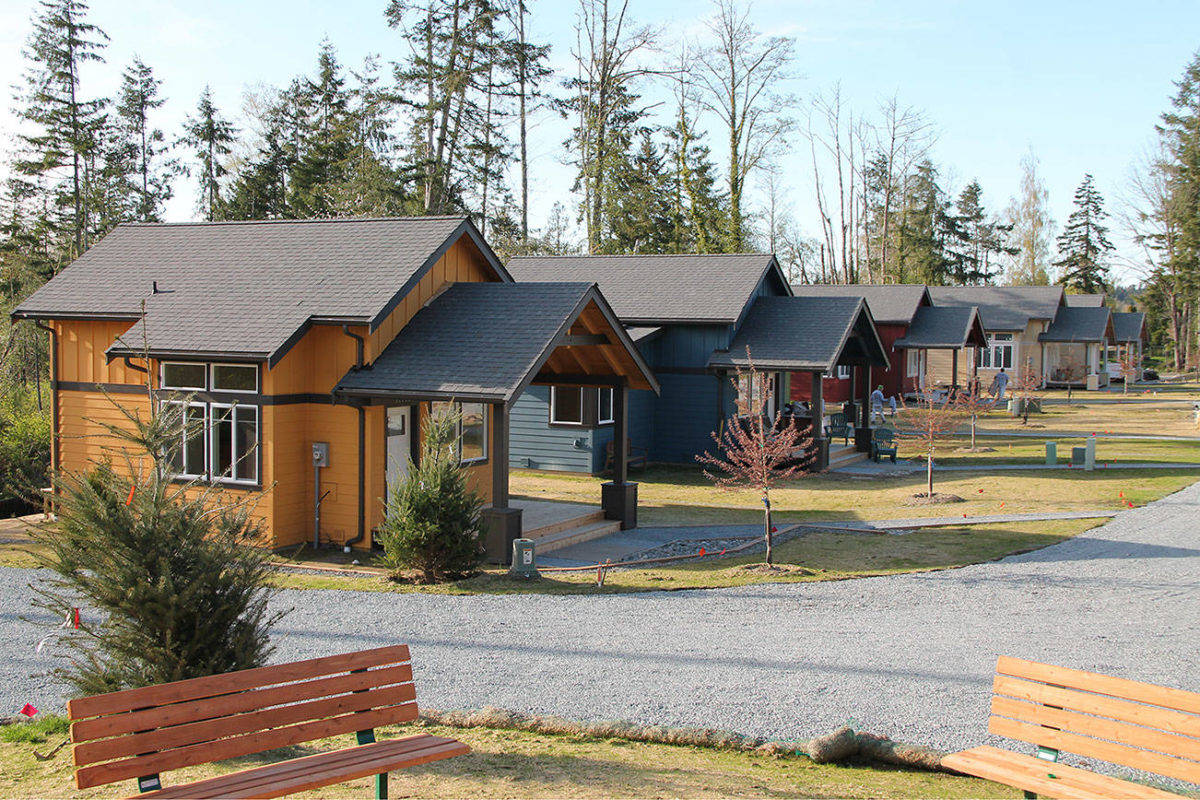While the affordable housing debate continues to rage throughout the Seattle metropolitan region, a handful of low-income homeowners are moving into a unique new development on Vashon Island.
The Sunflower, a project of Vashon Household, consists of 14 homes and serves those earning 80 percent or less of the area median income—$46,100 for one person and $52,650 for two. Like the nearby Roseballen community, Sunflower makes use of a community land trust model: Vashon HouseHold owns the land, while the homeowners own the houses and maintain a low-cost 99-year lease on the land. This approach kept the sale price of the homes to $170,000, far less than the 2016 median price of a home on Vashon—$535,000.
Vashon HouseHold—and the architect who designed the houses, Judy Tucker of Seattle’s Form and Function—tapped into the current interest in smaller homes. Each of the residences is about 750 square feet and includes full-size appliances, a bedroom, loft and large front porch. Vashon HouseHold Executive Director Chris Szala said there had been some concern that the small homes would not be marketable, but that was not the case, as the homes were sold out within two weeks after the opportunity was announced.
Among the new homeowners is islander Lori Spears, a mother of two grown children who works as a therapist in West Seattle. Last Friday, she was the first to move into the community, as her home was among the first to be completed. She took a break to share her experience—and enthusiasm—noting that she had been a renter for the last eight years and had been worried she would have to leave the island.
“I was really fearful of the rising rents. It is exciting to know I have a home,” she said, standing on her new front porch, many of her belongings spread out around her.
Initially, she and her 19-year-old son will live in the home together, while he decides what he would like to do next. Spears acknowledged she had some concerns about the size of her home, particularly regarding storage. She left behind a three-bedroom house, where she raised her children, but is optimistic about downsizing.
“I have lots of ideas about how to get creative. I feel confident I will make it work,” she said. “It’s good to evaluate what I really need to keep and what to let go.”
This weekend, Erica Wagner, who grew up on the island, will move into her home just across the gravel drive from Spears. Wagner, 31, works as a program coordinator at Harborview Medical Center, and had rented apartments in Seattle and Bellevue. Like Spears, she was concerned about rising rents, but until she learned about Sunflower from her mother Patte Wagner, she had considered buying a home out of reach.
“I have a college degree and a job at a prestigious hospital, but still do not make enough money to buy a house in today’s housing market. It was not on my radar because of the high cost,” she said.
The way the Sunflower homes are designed makes them feel larger than they are, she said, noting their size is not a concern for her.
“I like the idea of small living,” she added.
Moreover, as a 2004 Vashon High School graduate, she is pleased to call Vashon home again.
“I love being back on the island,” she said. “It is a great place to retreat to, especially after coming home from the hospital.”
The Sunflower project, first announced in 2002, has been beset with problems. Several years ago, King County required Vashon HouseHold to lower the adjacent Bank Road, which was costly. The recession dried up funds for federally subsidized mortgages and caused the closing of Northwest Housing Development Corp., Vashon HouseHold’s former partner in the project.
Some challenges continued during the construction of the homes. Szala noted that considerable extra work was needed to get down to solid ground for the foundations, and the winter and spring, with their nearly unrelenting precipitation, caused delays and cost overruns as well. As an example, he noted that the construction budget called for $3,000 for dehumidification—a fraction of the total cost ultimately needed.
“We spent over $30,000 on dehumidification,” he said. “The January freezes and the pouring rain—it was a nightmare.”
Nonprofit housing developers are supposed to make money off projects through development fees to help them move ahead to their next project, but that did not occur with Sunflower, a $2.9 million project, Szala said. Vashon HouseHold had started the development with a healthy reserve, but put $400,000 into it to make it happen. Such a move was necessary, he stressed, stressing that the county and state had supported it financially.
“You cannot walk away from a public funder,” he added.
Now, the organization welcomes donations from those wishing to support affordable housing on the island to help offset some of its project-related costs. Donations would also help it look ahead while the final work is completed and the last of the residents move in—which Szala said should happen by the end of May.
As for what is next, Szala said his organization is considering options, including possibly creating affordable housing in a development that also includes service providers.
“We are actively looking at future projects,” he said.
news@seattleweekly.com
A version of this story was originally published at the Vashon-Maury Island Beachcomber.








